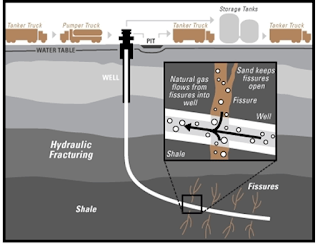Fracking - The risks, social & environmental costs
Fracking, the latest ethical challenge in the energy business
This case
study looks into the ethical issues of fracking. It asks the questions and endeavors to find answers;
should fracking be allowed or forbidden? Can the energy industry give
guarantees to people who may suffer personal, material or environmental damage
caused by this controversial exploration technique?
These
questions are already answered by several countries, at least for the time
being; France and Switzerland said no to fracking, at least now, whilst USA,
Poland and China said yes. But the
timing factor must be included; with high oil prices, fracking has become a
convenient alternative that may outweigh possible negative environmental
impact.
This research is not addressing the
fracking process itself, but looks at the human deliberation process and the
adherence to published HSE policies of energy companies’ regulations and their
stance on ethical and CSR issues performing this technique. According to the EPA, toxic chemicals in fracturing fluids include
substances such as polycyclic aromatic hydrocarbons; methanol; formaldehyde;
ethylene glycol; glycol ethers; hydrochloric acid; sodium hydroxide; and diesel
fuel, which contains benzene, ethyl benzene, toluene, xylene, naphthalene and
other chemicals. These chemicals have
known negative health effects such as respiratory, neurological, reproductive
side effects, and have an impact on the central nervous system. Some are known carcinogens.
WHAT IS
FRACKING?
Fracking is
short for hydro-fracking. Officially, it
is horizontal drilling coupled with multi-stage hydraulic fracturing and is a
relatively new process of natural gas extraction. Here's a step-by-step explanation of this
process.
· A well is drilled vertically to the
desired depth, then turns ninety degrees and continues horizontally for several
thousand feet into the shale believed to contain the trapped natural gas.
· A mix of water, sand, and various
chemicals is pumped into the well at high pressure in order to create fissures
in the shale through which the gas can escape.
As much a 4.5 million gallons of water is needed for one well.
· Natural gas escapes through the
fissures and is drawn back up the well to the surface, where it is processed,
refined, and shipped to market.
· Wastewater (also called "flow
back water" or "produced water") returns to the surface after
the fracking process is completed.
(Illustration
4: Fracking Visualization. Source:
Komai.co.com)
Fracking is
fundamentally different to traditional gas extraction methods.
· Fracking wells go thousands of feet
deeper than traditional natural gas wells.
· Fracking requires between two and
five million gallons (8000 -20000m3) of local freshwater per well - up to 100
times more than traditional extraction methods.
· Fracking utilizes "fracking
fluid," a mix of water, sand, and a cocktail of toxic chemicals. While companies performing fracking have
resisted disclosure of the exact contents of the fracking fluid by claiming
that this information is proprietary, studies of fracking waste indicate that
the fluid contains; formaldehyde, acetic acids, citric acids, and boric acids,
amongst hundreds of other chemical contaminants. The sand preferred is crystalline silica.
Since
horizontal drilling became a breakthrough technique to enable better release of
trapped shale gas from the earth’s crust, a debate between gas exploration
companies and environmentalists started.
People who are in favor claim that although this technique is not
risk-free, the economic advantages outweigh the environmental risks, which they
claim are controllable. In the light of
this research into the ethical deliberation process to ascertain and determine
whether known risks can be called controllable, insignificant or negligible and
therefore can be ignored, the fracking process was chosen.
Early
studies that stated that there was no risk were revoked in 2011 because real
damage to water sources, soil pollution and even earthquakes were proven. Maria
Kielmas, published an article in the Oil and Gas monthly magazine Petroleum
Review, issued by the Energy Institute in the UK, called ‘Shakin’ all over’, in
which she writes about the real time effects of fracking (Kielmas, Maria, 2012).
As an
example, Halliburton, one of the largest oil services companies in the world
providing the fracking industry with its equipment, was chosen.
They state
on their HSE policy:
‘The
Company will comply with all applicable Laws and relevant industry standards of
practice concerning protection of health and safety of its Employees in the
work place and other persons affected by its business activities and the
prevention of environmental pollution. Protection
of health, safety, and the prevention of pollution to the environment is a
primary goal of the Company and the management of the Company shall take such
actions as are reasonable and necessary to achieve such goals and carry out
this policy.’
A listing
of the various chemicals their fracking fluid consists of was found on the
Halliburton webpages (Appendix 13). One
of the chemicals used was named B-6, or Biocide (Appendix 14), that prevents or
limits growth of bacteria that can cause formation of hydrogen sulfide and can
physically plug flow of oil and gas into the well.
An
important detail of the MSDS on B-6 ‘precautionary environmental measures’ was:
prevent from entering sewers, waterways, or low areas. This chemical and others
listed can be found on the Halliburton Fracking Fluid Disclosure website, (Appendix
15). It features specific wells in areas and lists fracking chemicals,
including their Material Safety Data Sheets that are injected into the deep
soil.
The
fracturing of the earth itself cannot be controlled, to touch or contaminate,
for example, drinking water sources. Research
and photographs can be read or seen on the internet about possible polluting
impact and effects such as volatile gas escaping from drinking water taps in
kitchens. Risks and the effects on humans and the environment are taken. An
example can be given such as Oil and Gas companies claiming that the drilling
takes place far below water aquifers, thus contamination of drinking water with
gas is impossible. In a paper written by
the Senior Counsel of the US Geological Survey, he and his colleagues warn
about the risks, especially on water supply of fracking in NY State. (Horwitz,
Dusty et al, 2012).
CHEMICAL
ADDITIVES
Research
found out the volume of chemical additives used ranged from 0.5% to 2.0% of the
total volume which mainly consists of water and sand.
In 100 m3
volume of water there will be 1-2 m3 of additives. A body of scientists, physicians and
engineers for Health Energy, specialized in water treatment drew up a joint
statement and sent a letter addressed to the Governor of New York on September
15, 2011 (Appendix 18). In this letter
they stated and warned;
‘We urge
the State to reconsider its position that existing water filtration systems provide
adequate protection against the risk of hydraulic fracturing, should materials
from flow-back fluids migrate to lakes, reservoirs, or ground waters used for
municipal water supplies.’
FRAC SAND
MINING
Another
equally important issue concerning fracking is the fact that the fracking
process needs sand, in particular, crystalline silica. In the USA, this so called frac-sand is
mainly found in the rural part of Wisconsin.
In an article by Ellen Cantarow ‘The New Eco-Devastation of Rural
America’, frac-sand is mentioned to be a health hazard when people breathe in
the dust. (Cantarow, Ellen, 2012).
The Journal
of Scientific and Industrial Research published a research paper entitled ‘Effects
of Open Cast Mining on Soil Fertility’, which stated that large areas are
continually becoming unfertile in spite of efforts to grow vegetation on
degraded, mined land. These are some of
the potential future effects that cannot yet be calculated (Ghose, Mrinal,
2004).
The
following questions can be answered:
· Should Fracking be allowed or
forbidden? It can be allowed under certain conditions, but social and environmental costs must be included in the pricing.
· Can the energy industry give
guarantees to people who may suffer personal, material or environmental damage
caused by this controversial exploration? Yes
they can, but to a certain limit. Personal injury due to water contamination or
exposure to toxicwaste or possible death can never be compensated.
Environmental and social risks have to be acceptable. Future impact and potential social or environmental costs cannot yet be known.
Environmental and social risks have to be acceptable. Future impact and potential social or environmental costs cannot yet be known.
The choice is an ethical one: if people are at risk because the environment is damaged, fracking must not be allowed. Therefore in the Netherlands, Belgium or other densely populated area it is irresponsible to frack and would have to be forbidden.




Reacties
Een reactie posten